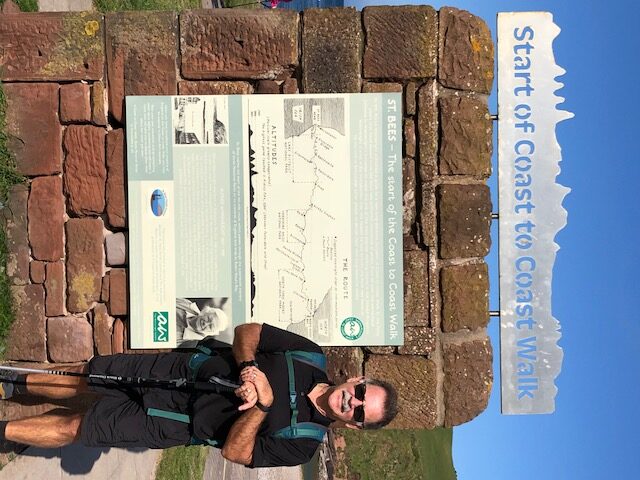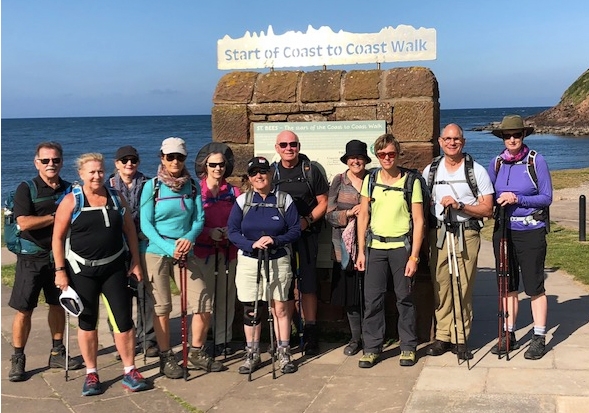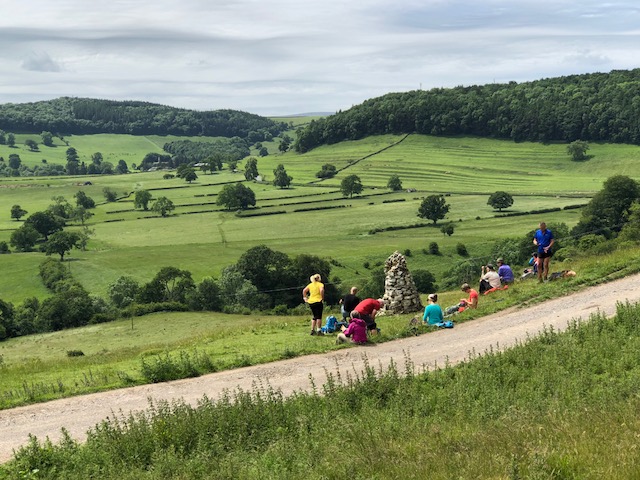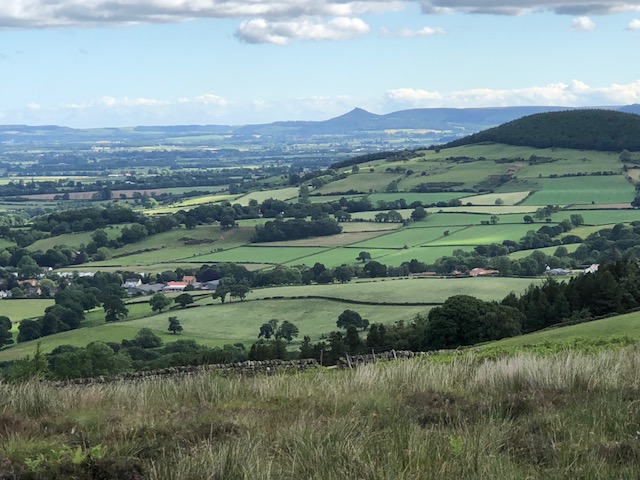From St Bees in Cumbria to Robin Hood’s Bay in Yorkshire
Dr Paul Batman tackles the Coast to Coast walk in the North of England and collects some interesting data along the way.
After 40 years of working and training in the fitness industry, I was recently diagnosed with a 90% blocked coronary artery. I was shattered, after teaching people for decades that if you were fit, ate a healthy diet, controlled your stress, etc. there was a significantly reduced likelihood that you would suffer from cardiovascular diseases.
My experience forced to me to re-evaluate what I had been teaching for all those years. I embarked upon a journey of discovery, researching information on oxidative stress, reactive oxygen species, tissue inflammation and CAD, atrial fibrillation, turbulent arterial blood flow, and nitric oxide changes in exercise among other subjects in an attempt to answer why this was happening to me.
The results of this investigation were life changing for me. I cut back dramatically on my high-intensity training and developed a movement programme based around non-exercise activity thermogenesis (NEAT). Typically NEAT is all the movements that we perform during the day outside of our 30-60-minute fitness sessions.
I called this programme NEAT Fit. Its aim is to reduce the barriers to exercise for the average person by converting daily inactive periods into meaningful active periods. This requires an assessment of the role of movement in their daily lives and a movement prescription based on MET minutes that creates active homes, active work/retirement/unemployment, active transport and active leisure.
As part of my own personal active leisure changes, I ditched the lazy beach drinking holidays and began to take active holidays where I could move for most of the day. To this end, I have been on cycling holidays, walking holidays and trekking holidays.
While I enjoyed trekking the Kokoda track in the Papua New Guinea jungle and walking the Camino in France and Spain, I was really interested in walking across the North of England along the Coast to Coast route from St Bees in Cumbria to Robin Hood’s Bay in Yorkshire that I had heard so much about.
I decided to undertake the walk in June 2018 and, as a means of monitoring my progress and the degree of difficulty of the walk, I decided to collect whatever data I could given the limitations of a light pack and the need to carry whatever it contained. I used my Garmin tracker to track distances and my Fibion to measure energy expenditure and different degrees of intensity.

I walked with a group of 11 people, 10 of whom were over 50 years of age, with the youngest 40 and the oldest 70. We walked for 13 days and covered over 340km without any rest days.
The following is a daily breakdown of distance covered, steps taken, energy expended, floors climbed, time walked and intensity levels (METs) of that journey.

Preliminary information
Distance covered: measured in kilometres over the course of the day.
Steps taken: measured over the course of the day.
Floors climbed: measured over the course of the day. One floor is reportedly equivalent to climbing 10 feet or 3 metres.
Energy expended: measured as kcals over the course of the day and includes daily resting energy expenditure.
Oxygen consumption: measured in METs over the daily distance of the walk, not the entire day. One (1) MET is equivalent to 3.5 mlO2/kg/min-1 and is equivalent to resting energy expenditure based on oxygen consumption. < 1.5 METs is resting or sedentary, 1.5-3 METs is classified as low intensity, 3-6 METs is classified as moderate intensity, while > 6 METs is classified as vigorous intensity.
Walking time: measured as hours and minutes for the duration of the walking day.
Day 1: St Bees to Ennerdale Bridge
The Coast to Coast walk typically is completed from West to East, starting at St Bees on the Irish Sea. The walk starts on the beach at St Bees and, after picking up a pebble that will be thrown in the North Sea on journey’s end as well as wetting your boots in the sea, it begins along the coastal cliffs and then inland over the hills of the Lake District. The climb up Dent Hill is the first tough physical test and the day finishes with a long walk into Ennerdale Bridge.
Distance covered: 27km
Steps walked: 42,142
Floors climbed: 100
Energy expenditure: 4,305kcals
Oxygen consumption: 3 hours 35 minutes > 6 METs (6 times resting energy expenditure) = >21 ml/kg/min-1
2 hours 25 minutes between 3.5 METs-6 METs (3.5-6 times resting energy expenditure) = 12.5 ml/kg/min-1– 21 ml/kg/min-1
12 minutes at < 3.5 METS (12.5 ml/kg/min-1 ) (3.5 times resting energy expenditure)
Walking time: 6 hours 12 minutes
Day 2: Ennerdale Bridge to Borrowdale
Walk along the shores of Ennerdale waters and then along the forest track to Black Sail Hut. This is followed by a steep climb up the Lowther Beck and then across lake fells, reaching the descending path into the Honister Slate Mine and then to Borrowdale.
Distance covered: 26km
Steps walked: 40,104
Floors climbed: 128
Energy expenditure: 4,646kcal
Oxygen consumption: 3 hours 13 minutes > 6 METs (6 times resting energy expenditure) > 21 ml/kg/min-1
2 hours 39 minutes between 3.5 METs-6 METs (3.5-6 times resting energy expenditure) = 12.5 ml/kg/min-1 –21 ml/kg/min-1
40 minutes at < 3.5 METS (12.5 ml/kg/min-1 ) (3.5 times resting energy expenditure)
Walking time: 6 hours 32 minutes
Day 3: Borrowdale to Grasmere
Walk along the lakes across the ridges and descend into Grasmere.
Distance covered: 23km
Steps walked: 32,345
Floors climbed: 104
Energy expenditure: 4,429kcal
Oxygen consumption: 2 hours 43 minutes > 6 METs (6 times resting energy expenditure) > 21 ml/kg/min-1
3 hours 28 minutes between 3.5 METs-6 METs (between 3.5 and 6 times resting energy expenditure) = 12.5 ml/kg/min-1 – 21 ml/kg/min-1
23 minutes at < 3.5 METs (12.5 ml/kg/min-1 )(3.5 times resting energy expenditure)
Walking time: 6 hours 34 minutes

Day 4: Grassmere to Patterdale
Walk over Grisedale Pass (2,000ft), around the lake and into Patterdale.
Distance covered: 14km
Steps walked: 19,368
Floors climbed: 99
Energy expenditure: 3,553kcal
Oxygen consumption: 1 hour 57 minutes > 6 METs (6 times resting energy expenditure) > 21 ml/kg/min-1
2 hours 31 minutes between 3.5 METs and 6 METs (3.5-6 times resting energy expenditure) = 12.5 ml/kg/min-1 – 21 ml/kg/min-1
38 minutes at < 3.5 METS (12.5 ml/kg/min-1 ) (3.5 times resting energy expenditure)
Walking time: 5 hours 6 minutes
Day 5: Patterdale to Shap
A demanding day starting with a steep climb past Angle Tarn and then continuing upwards to Kirsty Peak (2,560ft), the highest point in the walk, and then a descent into Haweswater before a gentler walk into Shap. This is the most easterly point of the Lake District.
Distance covered: 24.15km
Steps walked: 33,500
Floors climbed: 286
Energy expenditure: 4,882kcal
Oxygen consumption: 3 hours 25 minutes > 6 METs (6 times resting energy expenditure) > 21 ml/kg/min-1
2 hours 50 minutes between 3.5 METs- 6 METs (3.5-6 times resting energy expenditure) = 12.5 ml/kg/min-1– 21 ml/kg/min-1
40 minutes at < 3.5 METS (12.5 ml/kg/min-1 ) (3.5 times resting energy expenditure)
Walking time: 6 hours 55 minutes
Day 6: Shap to Kirkby Stephen
Walking between Cumbria and the Yorkshire Dales there is a hilly section across the Limestone Moors. There are many ascents and descents around Smartdale Ridge and then into Kirkby Stephen.
Distance covered: 33.71km
Steps walked: 46,755
Floors climbed: 129
Energy expenditure: 5,525 kcals
Oxygen consumption: 5 hours 42 minutes > 6 METs (6 times resting energy expenditure) > 21 ml/kg/min-1
1 hour 34 minutes between 3.5-6 METs (3.5-6 times resting energy expenditure) = 12.5 ml/kg/min-1 – 21 ml/kg/min-1
20 minutes at < 3.5 METs (12.5 ml/kg/min-1 ) (3.5 times resting energy expenditure)
Walking time: 7 hours 36 minutes
Day 7: Kirkby Stephen to Keld
Climb out of Kirkby Stephen to the Nine Standards (2,170ft) and then across the muddy moors and down into Keld.
Distance covered: 24km
Steps walked: 33,150
Floors climbed: 137
Energy expenditure: 4,352kcal
Oxygen consumption: 2 hours 54 minutes > 6 METs (6 times resting energy expenditure) > 21 ml/kg/min-1
3 hours 26 minutes between 3.5 and 6 METs (3.5-6 times resting energy expenditure) = 12.5 ml/kg/min-1 – 21 ml/kg/min-1
28 minutes at < 3.5 METS (12.5 ml/kg/min-1 ) (3.5 times resting energy expenditure)
Walking time: 6 hours 48 minutes
Day 8: Keld to Reeth
We took the higher alternative over the windy moorland and through the lead mines.
Distance covered: 25.3km
Steps walked: 34,198
Floors climbed: 135
Energy expenditure: 4,952kcal
Oxygen consumption: 4 hours 10 minutes > 6 METs (6 times resting energy expenditure) > 21 ml/kg/min-1
1 hour 50 minutes between 3.5 and 6 METs (3.5-6 times resting energy expenditure) = 12.5 ml/kg/min-1 – 21 ml/kg/min-1
23 minutes at < 3.5 METs (12.5 ml/kg/min-1 ) (3.5 times resting energy expenditure)
Walking time: 6 hours 23 minutes
Day 9: Reeth to Richmond
Walk through Swaledale and into Richmond.
Distance covered: 22.3km
Steps walked: 30,837
Floors climbed: 104
Energy expenditure: 4,484kcal
Oxygen consumption: 3 hours 51 minutes > 6 METs (6 times resting energy expenditure) > 21 ml/kg/min-1
1 hour 34 minutes between 3.5 and 6 METs (3.5-6 times resting energy expenditure) = 12.5 ml/kg/min-1 – 21 ml/kg/min-1
35 minutes at < 3.5 METs (12.5 ml/kg/min-1 ) (3.5 times resting energy expenditure)
Walking time: 6 hours
Day 10: Richmond to Osmotherley
This is the longest and flattest day of the walk, bringing together the Yorkshire Dales and the North York Moors National Park.
Distance covered: 39.40km
Steps walked: 54,654
Floors climbed: 63
Energy expenditure: 6,202kcal
Oxygen consumption: 6 hours 20 minutes > 6 METs (6 times resting energy expenditure) > 21 ml/kg/min-1
1 hour 11 minutes between 3.5 and 6 METs (3.- 6 times resting energy expenditure) = 12.5 ml/kg/min-1 – 21 ml/kg/min-1
18 minutes at < 3.5 METs (12.5 ml/kg/min-1 ) (3.5 times resting energy expenditure)
Walking time: 7 hours 49 minutes
Day 11: Osmotherley to Blakely
A demanding day with many ascents and descents in the Cleveland hills, then across the moors to Rosedale and then up to Claybank Top, followed by a long, flat walk to Blakely.
Distance covered: 32.07km
Steps walked: 44,470
Floors climbed: 196
Energy Eexpenditure: 5,965kcal
Oxygen consumption: 5 hours 37 minutes > 6 METs (6 times resting energy expenditure) > 21 ml/kg/min-1
1 hour 37 minutes between 3.5 and 6 METs (3.5-6 times resting energy expenditure) = 12.5 ml/kg/min-1 – 21 ml/kg/min-1
12 minutes at < 3.5 METs (12.5 ml/kg/min-1 ) (3.5 times resting energy expenditure)
Walking time: 7 hours 26 minutes
Day 12: Blakely to Egton Bridge
A walk along the road past Fat Betty before an undulating descent down into Eskdale, along the River Esk and into Egton Bridge.
Distance covered: 21.5km
Steps walked: 29,910
Floors climbed: 33
Energy expenditure: 4,264kcal
Oxygen consumption: 4 hours 2 minutes > 6 METs (6 times resting energy expenditure) > 21 ml/kg/min-1
46 minutes between 3.5 and 6 METs (3.5-6 times resting energy expenditure) = 12.5 ml/kg/min-1 – 21 ml/kg/min-1
20 minutes at < 3.5 METs (12.5 ml/kg/min-1 ) (3.5 times resting energy expenditure)
Walking time: 5 hours 8 minutes
Day 13: Egton Bridge to Robin Hood’s Bay
A walk along roads up the moors looking down to Whitby. From the high moors, the last 5km is along the coastal track to Robin Hood’s Bay.
Distance covered: 28.39km
Steps walked: 39,380
Floors climbed: 175
Energy expenditure: 4,855kcals
Oxygen consumption: 3 hours 13 minutes > 6 METs (6 times resting energy expenditure) > 21 ml/kg/min-1
2 hours 35 minutes between 3.5 and 6 METs (3.5-6 times resting energy expenditure) = 12.5 ml/kg/min-1 – 21 ml/kg/min-1
16 minutes at < 3.5 METs (12.5 ml/kg/min-1) = 12 (3.5 times resting energy expenditure)
Walking time: 6 hours 4 minutes
Data summary from the Coast to Coast walk

Distance covered: 340.82km
Average daily distance covered: 26.2km
Total walking time: 84 hours 11 minutes
Average walking time per day: 6 hours 25 minutes at a daily average speed of 4km per hour
Steps taken: 480,813
Average daily steps: 36,985
Energy expended: 62,814kcal
Average daily energy expenditure: 4,831kcal
Floors climbed: 1,639
Average daily floors climbed: 126
Time spent at > 6 METs (> 21 ml/kg/min-1) is 51 hours 39 minutes (vigorous intensity)
Average daily time > 6 METs is 3 hours 58 minutes
Average daily MET minutes > 6 METs is 1,428 MET minutes
Time spent between 3.5 and 6 METs (12.5 ml/kg/min-1 – 21 ml/kg/min-1 ) is 27 hours 7 minutes (moderate intensity)
Average daily time spent between 3.5 and 6 METs is 2 hours and 5 minutes
Average daily MET minutes between 3.5 METs and 6 METs is 437-750 MET minutes
Time spent < 3.5 METs (<12.5 ml/kg/min-1): 5 hours 25 minutes (low intensity)
Average daily time < 3.5 METs = 25 minutes per day
Average daily MET minutes < 3.5 METs = 87 MET minutes
NB: For health benefits, the World Health Organization (WHO) recommends a minimum of 150 minutes of moderate intensity activity per week (five days) at an intensity of 4 METs = 600 MET minutes or 75 minutes of vigorous intensity activity per week (five days) at 6 METs = 450 MET minutes.
Average daily MET minutes based on the WHO recommendations at a moderate intensity = 120 MET minutes.
Average daily MET minutes based on the WHO recommendation at a vigorous intensity = 90 MET minutes.
The daily MET minutes for moderate intensity on the Coast to Coast was between 437 and 750 MET minutes, which is three to eight times the WHO daily recommendations.
The daily MET minutes for vigorous intensity on the Coast to Coast was 1,428 MET minutes, which is over 15 times the WHO daily recommendations of 90 MET minutes!
Where to next? Find out about urban adventure medicine for your next big adventure in the great outdoors.








